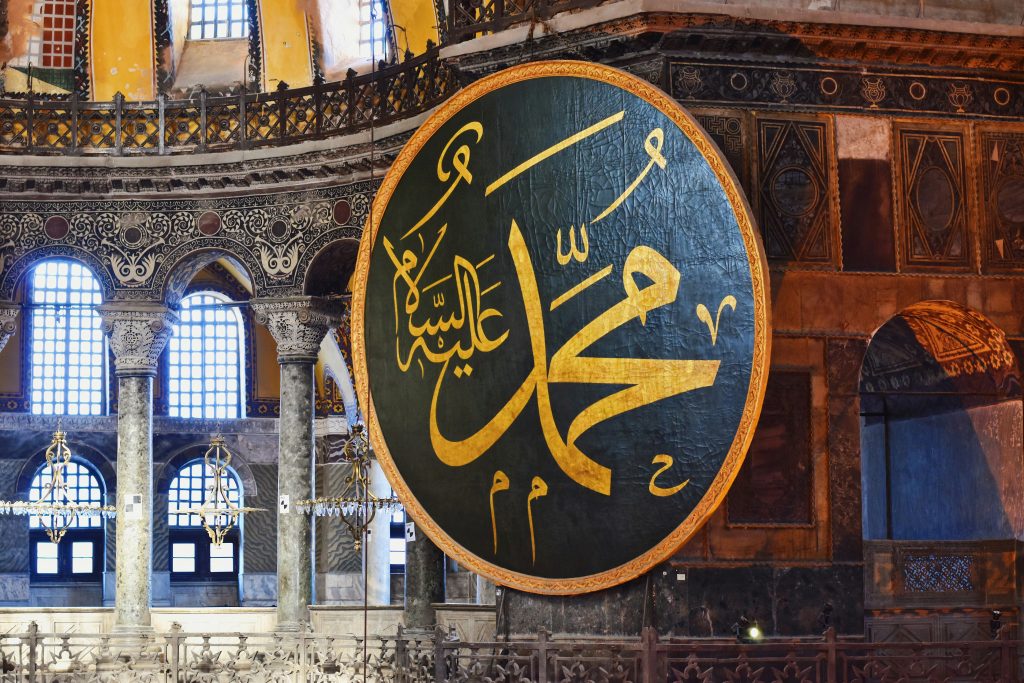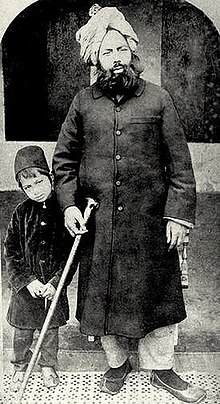Hazrat Mirza Ghulam Ahmad of Qadian (peace be upon him) claimed to be the Promised Messiah and Mahdi. He states in A Gift for An-Nadwa,
“I am a Prophet of God in a Zilli and Buruzi sense” (15),
meaning that he was a shadow of the Holy Prophet (peace and blessings of Allah be upon him), and that he achieved prophethood through perfect submission to the Holy Prophet (peace and blessings of Allah be upon him). He further states in Nuzul-ul-Masih, “Take careful note of this point, and always bear it in mind, that I am not a Rasul and Prophet in the sense of having brought a new Sharia, a new claim, and a new name; and I am a Nabi and a Rasul, that is with respect of perfect Zilliyyat, I am the mirrors in which the qualities and Nabuwwat of the Holy Prophet Muhammad (peace and blessings of Allah be upon him) have been reflected perfectly” (3). In Noah’s Ark, the Promised Messiah (peace be upon him) explains some revelations which were recorded in Barahin-e-Ahmadiyya, which call him Jesus (peace be upon him) and Mary (peace be upon him). Some misguided souls wrongly believe that the Messiah of the latter days and Jesus, the son of Mary (peace be upon him), who was sent to the Israelites, would be the same person.

The truth is they would be very similar in their station and their mission – this is the meaning of Buruz. Imam Razi explains in Tafsir-e-Kabir:
إطْلاقُ اسْمِ الشَّيْءِ عَلى ما يُشابِهُهُ في أكْثَرِ خَواصِّهِ وصِفاتِهِ جائِزٌ حَسَنٌ
“The giving of a name of a thing to what is similar to it in most of its properties and qualities is permissible and good.”
(Chapter 3: verse 55)
Explaining this concept, Allama Zamakhshari states in his commentary, Al-Kashaaf:
هَذَا كَقَولِكَ أَبُو يُوسُفَ أَبُو حَنِيفَةَ تُرِيدُ أَنَّهُ لِاستِحكَامِ الشِّبهِ كَأَنَّ ذَاتَهُ ذَاتُهُ
“It, [the provisions of the afterlife being called the provisions of the world,] is like your saying that Abu Yusuf is Abu Hanifa and this means that between them there is a strong resemblance so Abu Yusuf’s person is considered to be Abu Hanifa’s person.” (Chapter 2: verse 25)
Again, Allama Abaidullah bin Masood Hanafi writes in his book At-Taudih:
اِستِعَارَةِ اسمِ أَبِي حَنِيفَةَ رَحِمَهُ اللهُ تَعَالَى لِرَجُل عَالَم فَقِيه مُتَّق
Meaning that for a man who is scholarly, a jurist, and righteous, the name of Abu Hanifa (may Allah have mercy on him) is metaphorically applied.
Similarly, a Hadith of Sahih Bukhari also gives validation to the historical usage of Buruzi terminology in the time of the Holy Prophet (peace and blessings of Allah be upon him), as when the ruler of Rome received a letter from the Holy Prophet (peace and blessings of Allah be upon him) inviting him to Islam, he asked Abu Sufyan about the Holy Prophet’s (peace and blessings of Allah be upon him) background, and after having left the court of the king, Abu Sufyan said to his companions:
لَقَدْ أَمِرَ أَمْرُ ابْنِ أَبِي كَبْشَةَ، إِنَّهُ يَخَافُهُ مَلِكُ بَنِي الأَصْفَرِ.
“The matter of Ibn-Abi-Kabsha (meaning the Holy Prophet) has become so prominent that even the King of Bani Al-Asfar (Byzantine) is afraid of him.”
The Holy Prophet (peace and blessings of Allah be upon him) has been called Ibn Abi Kabsha here because Ibn Abi Kabsha used to worship one God, just as the Holy Prophet (peace and blessings of Allah be upon him) worshiped one God, even though the Holy Prophet’s name was Muhammad bin Abdullah (peace and blessings of Allah be upon him). The resemblance in this trait between the two personalities is enough that the latter can be called by the former’s name.
In the Bible, the coming of Elijah is clearly mentioned: “Behold, I will send you Elijah the prophet before the coming of the great and dreadful day of the LORD” (King James Bible, Malachi 4:5). Jews believe that Elijah is in the heavens, waiting to descend before the advent of the true Messiah (Elijah the Prophet, Rabbi Eliot Goldberg) as is mentioned in the Bible: “And it came to pass, as they still went on, and talked, that, behold, there appeared a chariot of fire, and horses of fire, and parted them both asunder; and Elijah went up by a whirlwind into heaven” (2 Kings 2:11). However, Jesus (peace be upon him) says, “For all the Prophets and the Law prophesied until John. And if you are willing to accept it, he is the Elijah who was to come” (Matthew, 11: 13-14). Jews argue that the verses of Malachi are clear that Elijah himself must appear before the true messiah’s advent in bodily form, as the verse lacks the words “like Elijah” or “similar to Elijah” (Chapter 33, The Coming of Elijah). However, Christians believe that John the Baptist was Elijah in “spirit and power,” or in a buruzi sense.
The Promised Messiah (peace be upon him) summarizes this point beautifully:
“In these prophecies it is clearly stated that Elijah (peace be upon him) would re-appear before the advent of the true Messiah and prophecies containing this condition are contained in the revealed books. But since Elijah (peace be upon him) did not re-appear, therefore the claim of Jesus (peace be upon him) to Messiahship could not be regarded as true by the Jews. When confronted with this difficulty, Jesus (peace be upon him) replied that by the appearance of Elijah was meant the appearance of one like him, and not his own appearance. But this explanation was rejected by the Jews as directly opposed to the Word of God which spoke not of the advent of the like of Elijah, but of the advent of Elijah (peace be upon him) himself. These considerations show clearly that the prophecies relating to the appearance of the prophets of God are always deep so that they may serve to distinguish the righteous from the wicked” (My Claim to Promised Messiahship, The Review of Religions).
Similarly, the Muslims of today believe that Jesus (peace be upon him) will descend to the earth from the heavens in bodily form and revive Islam. They too use a verse from the scripture to try to prove their claim, but other verses of the Holy Quran and sayings of the Holy Prophet (peace and blessings of Allah be upon him) clearly show that Jesus (peace be upon him) has passed away, and that the Messiah to come must be from amongst the Muslims. So, the Promised Messiah, Hazrat Mirza Ghulam Ahmad (peace be upon him), has clearly stated, while referring to himself: “The true Messiah is he who has appeared in time and made known his appearance to the world.” He also states: “In the chapter entitled the Tahrim, it is indicated that some individuals from among the Muslims would be called Ibn-i-Maryam (the Son of Mary), for in this chapter at first the faithful are compared to Mary and afterwards the breathing of a soul into her (i.e., the faithful like her) is mentioned. This indicates that the faithful who observe complete obedience to Divine commandments and make themselves like Mary, will be rewarded by God by being made Christ-like. It is in reference to the attainment of this stage that Almighty God says of me in a revelation published in the Barahin-e-Ahmadiyya: “O Mary! Enter thou and thy friends into paradise;’’ and again: “O Mary! I have breathed into thee the soul of truth,” (thus symbolically Mary was impregnated with truth); and last of all: “O Jesus! I will cause thee to die a natural death and would then raise thee to Myself,” where I am addressed as Jesus Christ as if raised from the dignity of Mary to the dignity of Christ. Thus the promise contained in the Tahrim has been fulfilled in me, and I am named by God as the son of Mary” (My Claim to Promised Messiahship, The Review of Religions).

The Promised Messiah (peace be upon him) has done us a great favor by explaining these subtle points about the fulfillment of such prophecies. The Jews and the non-Ahmadi Muslims of today bear a striking resemblance in that they both take the prophecies about their messiah too literally and reject the possibility of a metaphorical fulfillment of the prophecy. Such an attitude is the wont of the disbelievers, who look for any excuse to disobey God Almighty.
Another proof that the Promised Messiah (peace be upon him) of the Latter Days cannot be physically Jesus of Nazareth (peace be upon him) is the following Hadith:
عَنْ أَبِي هُرَيْرَةَ قَالَ : قَالَ رَسُولُ اللَّهِ صَلَّى اللَّهُ عَلَيْهِ وَآلِهِ وَسَلَّمَ : ” أَلَا ” إِنَّ عِيسَى ابْنَ مَرْيَمَ لَيْسَ بَيْنِي وَبَيْنَهُ نَبِيُّ ، أَلَا خَلِيفَتِي فِي أُمَّتِي مِنْ بَعْدِي يَقْتُلُ الدَّجَّالَ وَيَكْسِرُ الصَّلِيبَ وَيَضَعُ الْجِزْيَةَ وَتَضَعُ الْحَرْبُ أَوْزَارَهَا , أَلَا مَنْ أَدْرَكَهُ مِنْكُمْ , فَلْيَقْرَأْ عَلَيْهِ السَّلَامَ “
“Narrated Abu Hurairah (may Allah be pleased with him): The Holy Prophet Muhammad (peace and blessings of Allah be upon him) said: “Hearken! There is no Prophet and Messenger between me and the Jesus son of Mary. He is the Khalifa in my Ummah after me. Verily, he will kill the Dajjal, and break the cross, and abolish war. Anyone from among you who sees him, should convey my Salam to him” (Tabarani, Hadith 5040).
One point to note in this Hadith is the fact that Jesus of Mary is said to be from the Ummah of the Holy Prophet (peace and blessings of Allah be upon him) his Khalifah or successor. If this Hadith is taken literally, then the meaning would be that Jesus of Nazareth came after the Holy Prophet (peace and blessings of Allah be upon him) and not before him, for if he came before the Holy Prophet (peace and blessings of Allah be upon him), he can neither be from the Prophet’s (peace and blessings of Allah be upon him) people nor can he be one who succeeds him. Rather, the Holy Prophet (peace and blessings of Allah be upon him) would be the one succeeding Jesus (peace be upon him), a notion no Muslim believes. Similarly, another Hadith proclaims that the Messiah would be “an Imam from among yourselves” (Bukhari, Hadith 3449), and that Jesus son of Mary will be the Imam and Mahdi. All these Ahadith point to the idea that the Jesus of the Latter Days will not be the same Jesus of Nazareth that came some two thousand years ago. If he were the same person, the words of the Hadith should have indicated that this Khalifa and Imam will not be a person from amongst the Muslims, but a person from outside the Muslims.
Buruz is not some new notion conjured up by Ahmadis to support the idea that Jesus son of Mary was a metaphor indicating the similarities between the Messiah of Islam and the Mosaic Messiah; rather, this concept has existed before Islam came into the world. As Hazrat Shaikh Abdul Qadir Jilani (rh) said:
هَذَا وَجُودُ جَدِّي مُحَمَّد صَلَى اللهُ عَلَيهِ وَسَلَّمَ لَا وَجُودَ عَبدِ القَادِرِ.
“My existence is the existence of my grandfather Muhammad, peace and blessings of Allah be upon him, not the existence of Abdul Qadir” (Guldasta Kiraamaat 8).
May God the Almighty enable the world to understand this delicate subject so they may not remain ignorant of the coming of the Messiah who has distributed among his community a wealth of spiritual treasure and guidance, Ameen!
